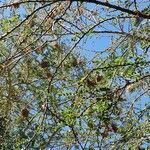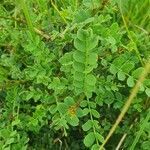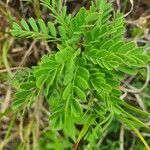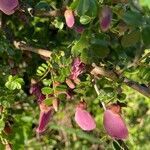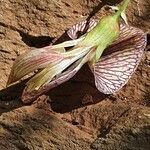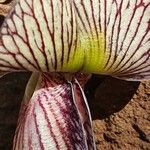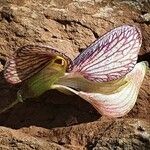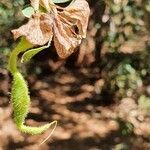Shrub or small tree 2-9 m tall with mostly whitish branchlets, sparsely white-pubescent at first and with some persistent swollen-based hairs; bark rough, corky, longitudinally furrowed; older stems rough with a covering of old short shoots. Leaves single and spaced out on long young shoots but later fasciculate on short shoots; leaflets 7-13(17), 6-12(24) x 2-7(12) mm, elliptic-oblong, or the terminal one obovate, truncate, emarginate or rounded and mucronate at the apex, rounded or slightly subcordate at the base, the margins revolute, glabrous to sparsely to ± densely appressed white-pubescent beneath; lateral veins mostly scarcely visible, rarely dark; petiole 5-13 mm long; rhachis 2-4(7) cm long with white and swollen-based hairs; stipules up to 6 mm long, lanceolate, striate. Racemes 1-3-flowered, up to 15 mm long but usually short, white pubescent; peduncle 0-10 mm long; pedicels up to 17 mm long; bracts and bracteoles c. 2-3.5 mm long, ovate, the latter 1-5 mm below the receptacle. Calyx glabrous save on the margins, or rarely some white pubescence on the lobes but never with swollen-based hairs; receptacle 1 mm long; calyx tube 3-4 mm long, the upper lobes 3-6 mm long, rounded, joined for half their length, lateral lobes 5-8 mm long, broadly triangular, obtuse, lower lobe lanceolate, boat-shaped, acute. Corolla persistent, pinkish or purple, rather obscurely veined or pinkish-yellow with purple veins; standard blade 12-17(26) x 15-20(29) mm, broadly ovate or transversely elliptic, emarginate, cordate, with two rounded appendages at the base, usually with rather cottony hairs around the margins; claw 3-4 mm long. Stamens diadelphous in 2 bundles of 5, or rarely monadelphous. Ovary 5-6-ovulate, densely pubescent with swollen-based hairs. Pod rarely maturing, possibly due to insect attack, coiled within the persistent corolla, mostly only 1-seeded, pubescent, glandular and minutely tuberculate; articles 6-8 x 3-5 mm, 2-3 mm thick. Seeds straw-coloured, 3-4 x 2-2.5 x 1.5 mm, compressed-ellipsoid, smooth; seeds produced sparsely.
Leaves single and spaced out on long young shoots but later fasciculate on short shoots; leaflets 7–13(17), 6–12(24) × 2–7(12) mm, elliptic-oblong, or the terminal one obovate, truncate, emarginate or rounded and mucronate at the apex, rounded or slightly subcordate at the base, the margins revolute, glabrous to sparsely to ± densely appressed white-pubescent beneath; lateral veins mostly scarcely visible, rarely dark; petiole 5–13 mm long; rhachis 2–4(7) cm long with white and swollen-based hairs; stipules up to 6 mm long, lanceolate, striate.
A shrub or small tree. It grows 2-9 m tall. The small branches are white. The bark is rough, corky and has furrows along it. The leaves are single and spread out along the young shoots. There are 7-13 leaflets. They are 6-12 mm long by 2-7 mm wide. The flowers are in groups of 1-3. The fruit is a coiled pod. It usually has one seed.
Calyx glabrous save on the margins, or rarely some white pubescence on the lobes but never with swollen-based hairs; receptacle 1 mm long; calyx tube 3–4 mm long, the upper lobes 3–6 mm long, rounded, joined for half their length, lateral lobes 5–8 mm long, broadly triangular, obtuse, lower lobe lanceolate, boat-shaped, acute.
Corolla persistent, pinkish or purple, rather obscurely veined or pinkish-yellow with purple veins; standard blade 12–17(26) × 15–20(29) mm, broadly ovate or transversely elliptic, emarginate, cordate, with two rounded appendages at the base, usually with rather cottony hairs around the margins; claw 3–4 mm long.
Shrub or small tree 2–9 m tall with mostly whitish branchlets, sparsely white-pubescent at first and with some persistent swollen-based hairs; bark rough, corky, longitudinally furrowed; older stems rough with a covering of old short shoots.
Racemes 1–3-flowered, up to 15 mm long but usually short, white pubescent; peduncle 0–10 mm long; pedicels up to 17 mm long; bracts and bracteoles c. 2–3.5 mm long, ovate, the latter 1–5 mm below the receptacle.
Pod rarely maturing, possibly due to insect attack, coiled within the persistent corolla, mostly only 1-seeded, pubescent, glandular and minutely tuberculate; articles 6–8 × 3–5 mm, 2–3 mm thick.
Seeds straw-coloured, 3–4 × 2–2.5 × l.5 mm, compressed-ellipsoid, smooth; seeds produced sparsely.
Ovary 5–6-ovulate, densely pubescent with swollen-based hairs.
Stamens diadelphous in 2 bundles of 5, or rarely monadelphous.
